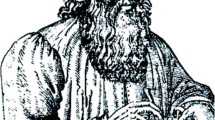Abstract
Paul of Aegina lived in a era when the preservation of the ancient Greek tradition was for him almost a necessity. Eager to follow the dogma of “oρθoπo(ε)δώ” (orthopodo: pace with no malformation), he introduced a series of surgical operations of reconstructive-cosmetic-plastic-orthopaedic nature to confront any disfiguration of the human body. The aim of our study is to present the atmosphere of the era concerning the congenital malformations, describe briefly Paul’s contribution on classic orthopaedics and present his views on the preternatural fingers. Our methodology mainly included the indexing of Paul’s treatise, as published by the Sydenham Society during the nineteenth century, while references from the ancient Greek scholars were added to compose a better understanding of Paul’s views. Inside his seven book treatise “Medical Compendium”, he dedicated a separate chapter “On preternatural fingers, and on persons having six fingers”, to introduce a detailed description of the extremities’ additional digits and propose surgical treatment for their correction. He classified polydactylism according both to the presence of bones and to the anatomical origin of each additional finger. Paul marked the beginning of a new era for orthopaedics.








Similar content being viewed by others
References
Barnett RD (1986–1987) Polydactylism in the ancient world. Bull Anglo-Israel Archaeol Soc 6
Banerjee M, Majumdar SK (2013) Hexadactyly in all four limbs in a neonate-a case report. J Dhaka Med Coll 22(2):219–222
Ennemoser J (1854) The history of magic, vol 2. Bohn, London, pp 28–29
King H (2004) Health in antiquity. Routledge, London, p 181
Kairi MN (1917) Eugenic. J Med Prog 1:261–339
Castiglioni A (1947) A history of medicine. Knoff, New York, pp 247–474
Kalantzis G, Tsiamis C, Poulakou-Rebelakou E (2006) Oribasius and Paul of Aegina: two pioneers of plastic surgery in Byzantium. Arch Hell Med 23(5):536–540
Evangelista SM (2009) British aestheticism and ancient Greece: Hellenism, reception, Gods in exile. Palgrave Macmillan, Basingstoke
Allen P (2000) The wages of sin: sex and disease, past and present. University of Chicago Press, Chicago, pp 7–8
Paulus Aegineta (1796–1861) Books I-VII, 3 vol, Adams Francis (trans.). Sydenham Society, London
Pournaropoulos GK (1903) The greek medicine in the middle ages. J Greek 4(1):1066
Pormann E (2004) The oriental tradition of Paul of Aegina’s pragmateia. Brill, Leiden, pp 4–5
Lemprière J, Lord E (1825) Lempriere’s universal biography. Lockwood, New York, p 438
Milne JS (1907) Surgical instruments in Greek and Roman times. Clarendon, Oxford, pp 51–69
Tsoucalas G, Sgantzos M, Androutsos G (2016) Hippocrates, principles on abdominal surgery in ancient Greece during the fifth century bc. Surg Innov 23(2):212–213
Tsoucalas G, Kousoulis AA, Tsoukalas I, Androutsos G (2011) The earliest mention of a black bag. Scand J Prim Health Care 29:196–197
Hippocrates (1967–1971) Opera [vol 6: On good manners] (in Greek). Martinos, Athens
Tsoucalas G, Sgantzos M (2016) Tracing the origins of the physician’s medical bag. Res Hist Med 5(2):55–70
Hippocrates (1849–1853) De natura muliebri & De mulierum affectibus i-iii & De visu (ed. É. Littré), [De la Nature de la Femme & Des Maladies des Femmes & De la Vision] Oeuvres complètes d’Hippocrate, vols. 7–9. Baillière, Paris (repr. Hakkert, Amsterdam: 1962)
Hippocrates (1840–1844) De morbis popularibus & De aëre aquis et locis & De fracturis & Aphorismi & De articulis (ed. É. Littré). Oeuvres complètes d’Hippocrate, vols. 2–5.Baillière, Paris, France (repr. Hakkert, Amsterdam:2:1961; 3:1961; 4:1862; 5:1962)
Hippocrates (1849) De locis in homine & De morbis popularibus & De fistulis & De humidorum usu & De ulceribus & De medico & De affectionibus (ed. É. Littré), Oeuvres complètes d’Hippocrate, vol. 6. Baillière, Paris (repr. Hakkert, Amsterdam: 1962)
Anagnostakis A (1889) Antiseptic methods in ancient Greek physicians. Galen [Γαληνός] 12:186
Divaris P (1902) Antisepsis in antiquity. Iatr Proodos [Iατριkή Πρόoδoς] 7:73–74
Blauth W, Olason AT (1988) Classification of polydactyly of the hands and feet. Arch Orthop Trauma Surg 107(6):334–344
Author information
Authors and Affiliations
Corresponding author
Ethics declarations
Conflict of interest
The authors declare that they have no conflict of interest.
Funding
There is no funding source.
Ethical approval
This article does not contain any studies with human participants or animals performed by any of the authors.
Rights and permissions
About this article
Cite this article
Tsoucalas, G., Sgantzos, M. Paul of Aegina (ca 625-690 AD), and his orthopaedic surgical reconstruction of the preternatural fingers. International Orthopaedics (SICOT) 41, 211–216 (2017). https://doi.org/10.1007/s00264-016-3304-2
Received:
Accepted:
Published:
Issue Date:
DOI: https://doi.org/10.1007/s00264-016-3304-2




